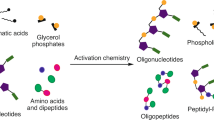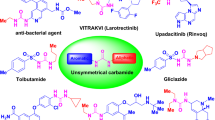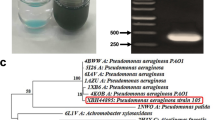Abstract
IN Zamecnik's laboratory, Frantz et al. 1 using dinitrophenol, found in liver slices a parallelism between the inhibition of phosphorylation and of amino-acid incorporation. Siekevitz2 demonstrated in a cell-free system a relation between oxidative phosphorylation and amino-acid incorporation in a crude rat-liver homogenate. Hoagland3 concluded from his experiments that the carboxyl groups of the amino-acids are activated by adenosine triphosphate, and that the activated amino-acyl groups are bound through an adenosine monophosphate bridge to an enzyme acting as an intermediate amino-acyl transfer compound. However, such intermediates have not yet been isolatedand identified. In their systems it was not possible to ‘exchange out’ the carbon-14 labelled amino-acids with large quantities of unlabelled amino-acids ; thus the incorporation was different from the exchange process described by Gale and Folkes4 in fragmented Staphylococcus aureus. J. T. Park5 has isolated uridine-5′-phosphate derivatives containing an amino-sugar and amino-acids from extracts of Staphylococcus aureus treated with penicillin. On the basis of these and a great number of other experiments, Borsook6 proposed a hypothesis for the mechanism of biosynthesis : the carboxyl groups of free amino-acids are first activated by an enzyme system dependent on adenosine triphosphate. They are then transported to a nucleic acid template by an unknown mechanism and are arranged in a specific sequence, the amino-acids being attached to the phosphate of nucleic acid by their carboxyl groups. On this template, the amino-acids are then linked by peptide bonds through the action of another enzyme, and the protein molecule peels off the template.
This is a preview of subscription content, access via your institution
Access options
Subscribe to this journal
Receive 51 print issues and online access
$199.00 per year
only $3.90 per issue
Buy this article
- Purchase on SpringerLink
- Instant access to full article PDF
Prices may be subject to local taxes which are calculated during checkout
Similar content being viewed by others
References
Frantz, jun., I. D., Zamecnik, P. C., Reese, J. W., and Stephenson, M. L., J. Biol. Chem., 174, 773 (1948).
Siekevitz, P., and Zamecnik, P. C., Fed. Proc., 10, 246 (1951). Siekevitz, P., J. Biol. Chem., 195, 549 (1952).
Hoagland, M. B., Biochim. Biophys. Acta, 16, 288 (1955); Fed. Proc., 14, 73 (1955). Hoagland, M. B., Keller, E. B., and Zamecnik, P. C., J. Biol. Chem., 218, 345 (1956).
Gale, E. F., and Folkes, J. P., Biochem. J., 59, 661 (1955).
Park, J. T., J. Biol. Chem., 194, 877, 885, 897 (1952).
Borsook, H., Conférences et rapports, 3ème Congrès International de Biochemie, 92 (Bruxelles, 1955).
Markham, R., and Smith, J. D., Biochem. J., 49, 402 (1951).
Wyatt, G. R., Nature, 166, 237 (1950).
Smith, J. D., and Markham, R., Biochem. J., 46, 509 (1950).
Author information
Authors and Affiliations
Rights and permissions
About this article
Cite this article
REITH, W. Incorporation of Radioactive Aspartic Acid into the Proteins and Related Fractions in Mice bearing the Ehrlich Ascites Carcinoma. Nature 178, 1393–1394 (1956). https://doi.org/10.1038/1781393a0
Issue date:
DOI: https://doi.org/10.1038/1781393a0



